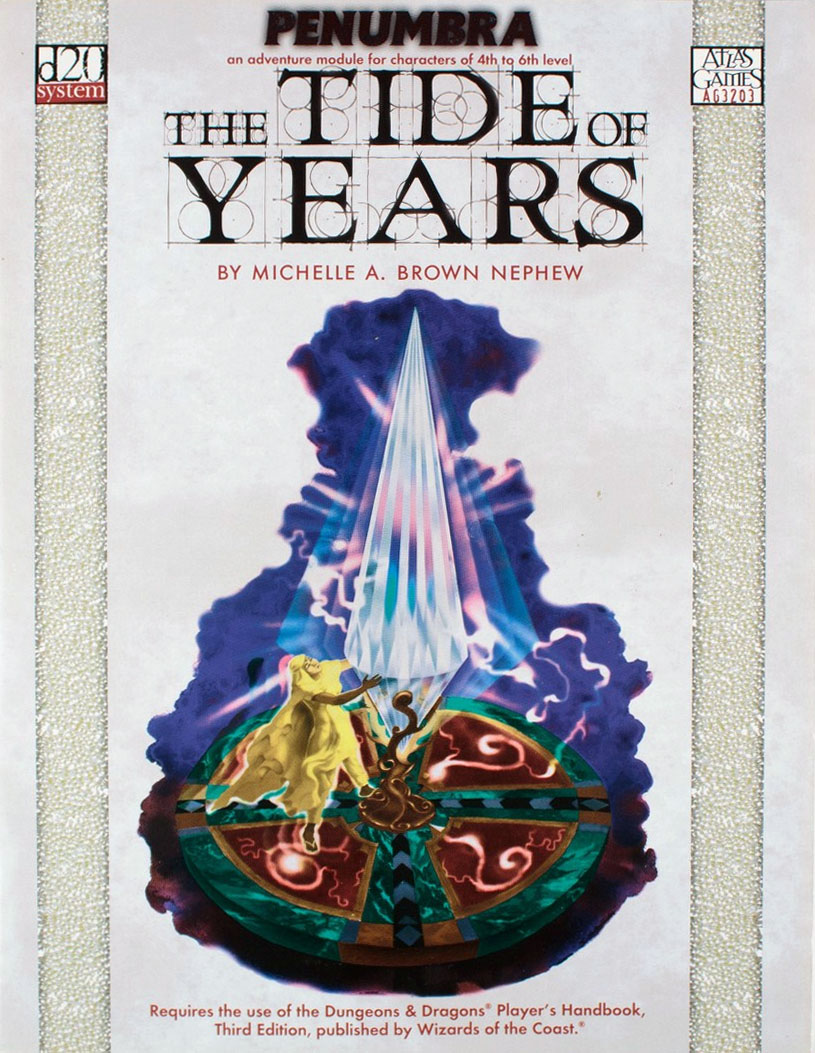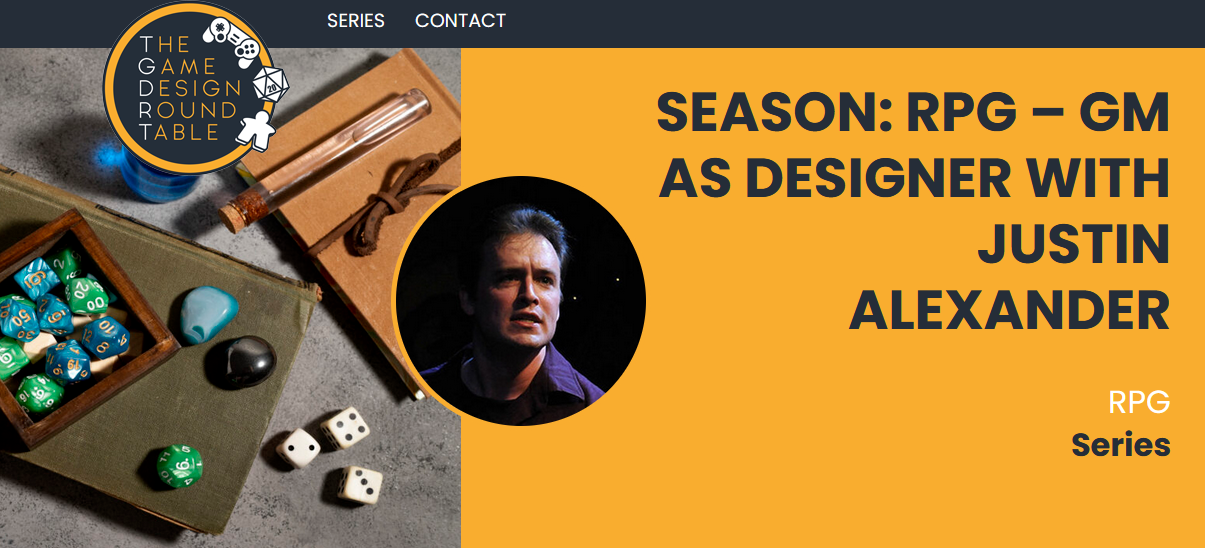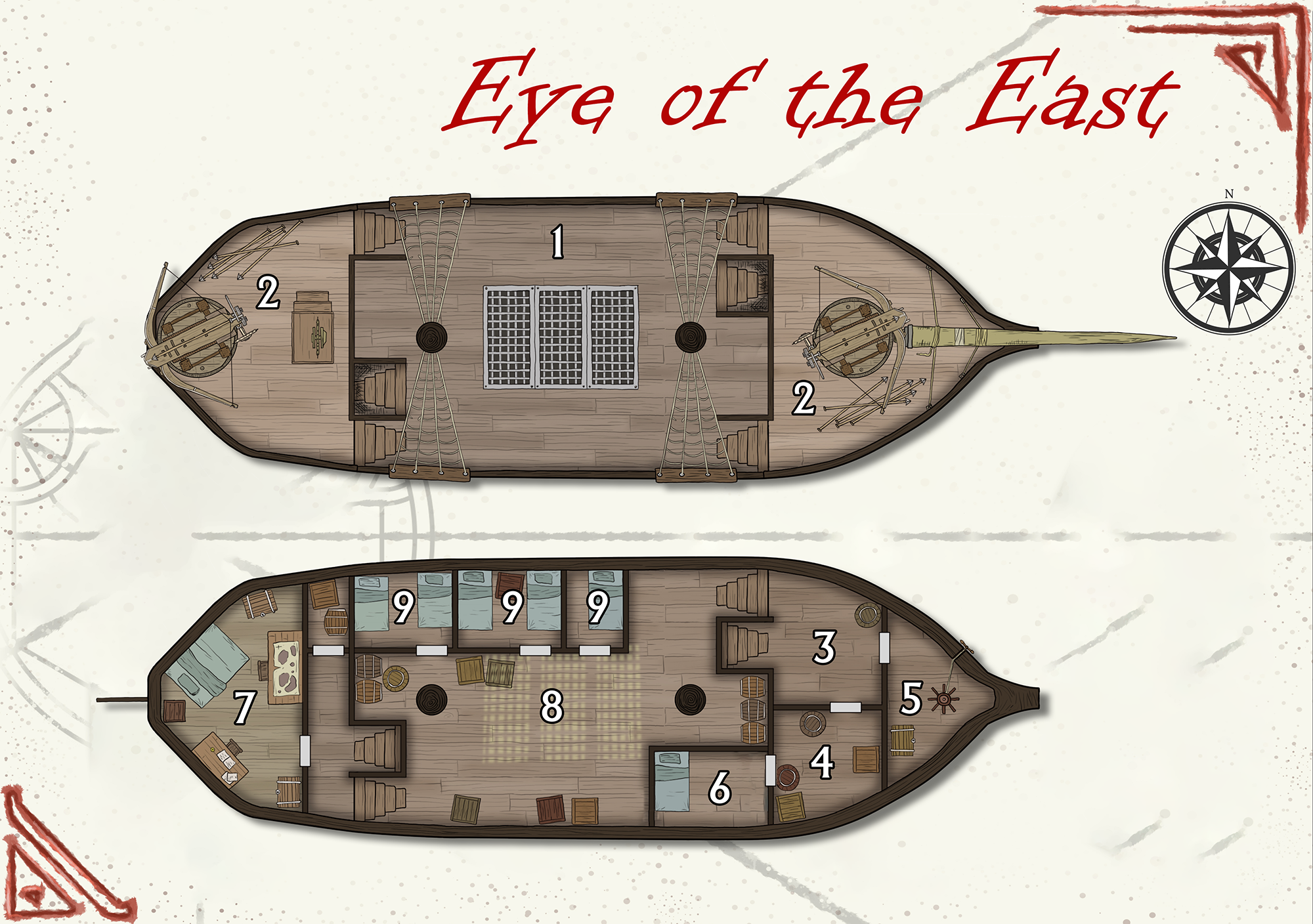Review Originally Published May 21st, 2001
With The Tide of Years Penumbra has gone from being one of the premiere D20 companies to being THE company producing D20 supplements – and I include Wizards of the Coast in that assessment. In The Tide of Years Penumbra not only introduces a new set of production values which are better than anything else in the D20 adventure market today, they apply them to a package which offers more material, of higher quality, than almost anything else in the D20 adventure market.
In short: This is good. This is very, very good.
PLOT
In the mists of antiquity there was a mighty empire: Lagueen. Lagueen was built upon the power of the Temporal Crystal, a powerful artifact which allowed the Priests of Ras’tan to unlock the secrets of time. From the ancient past and the distant future, Lagueen was able to harvest the greatest inventions and cultural treasures.
But Lagueen was brought low when a traitorous acolyte attempted to steal the Temporal Crystal. Although thwarted in her effort by a young priest named Jonar, the thief did succeed in activating the Temporal Crystal – transporting herself, Jonar, and the Crystal into the distant future. Unfortunately, without the Crystal, the marvelous society which had been created in Lagueen quickly fell apart. As their structures slowly collapsed from disuse and lack of repair, a landslide was triggered, blocking the end of the river valley in which Lagueen lay. “The river bloated and the valley floor flooded, covering the remains of Lagueen in a shroud of murky waters.” When the thief and priest reappeared, they found themselves at the bottom of an immense lake and quickly drowned.
Enter the PCs, who are, of course, passing through the forest which has grown up around the lake in which Lagueen has sunk. They are approached by the ghost of Jonar, who wants to set things right. The reappearance of the crystal has also triggered a temporal disturbance, slowly reverting the forest to a primeval state. Jonar will lead them through the valley to recover one of the temporal shards which the empire of Lagueen used in coordination with the Temporal Crystal to power their arcane technology. He will also introduce them to a local nixie, who will be able to grant them the ability to breathe underwater.
From here, of course, the PCs must journey beneath the lake – journeying to the sunken city of Lagueen, and (most importantly) the Temple of Ras’Tan in which the Temporal Crystal now lies. The temporal shard will unlock the temple’s ancient doors, but even once they’re inside the PCs will still need to deal with the ancient temporal traps laid in Lagueen’s golden age and the subterranean monsters which have taken up residence within the temple.
Once they reach the crystal, the PCs can return it to its proper place – just moments after the thief took it from Lagueen. This, of course, changes history, which can have one of two effects on the campaign world: First, the PCs’ actions may simply create an alternate dimension in which Lagueen never fell. On the other hand, the PCs may actually change their own world (the effect of this can be minimized by keeping Lagueen as a hidden kingdom, which has deliberately decided to keep its contact with the outside world to a minimum; or you can fully embrace the cataclysmic change).
STRENGTHS
Despite the critical success of their first adventure (Three Days to Kill) and their subsequent D20 products (Thieves in the Forest and In the Belly of the Beast), Atlas Games has not been content to simply rest on their laurels and repeat their past successes. Each new Penumbra product has improved upon the last, and each has taken pains to explore new territory. And this willingness to explore, experiment, and improve has ended up paying big dividends for Atlas Games – and, more importantly, the gamers who have followed their product line.
And with The Tide of Years they’ve raised the stakes one more time: The graphical look of the adventure is better than just about anything else being put out for D20 (and that includes Wizards of the Coast). The amount of material has been doubled over their previous efforts, and the quality of that material remains as high and innovative as ever – not only presenting the adventure itself, but (in the course of that adventure) providing a number of generic resources: New monsters (compsognathus, icthyosaur, monstrous aquatic spider, and time elemental), a new god (Ras’tan, God of Time), a new clerical domain (time), new cleric spells (detect temporal disturbance, dispel temporal effect, scry the ages, hastening of age, and wellspring of youth), new traps (temporal skids and temporal lags), a new magic item (the temporal shard), and the “lost empire” of Lagueen (which, like Deeptown in Three Days to Kill, is generic enough to be slipped into almost any generic fantasy campaign – while, at the same time, being unique and distinctive enough to be a memorable element of that campaign).
WEAKNESSES
The interior artwork, while of high quality, sometimes seems to be skewed from the text. For example, an underwater pyramid is shown – but it’s not the pyramid described in the text, and the characters swimming around it are wearing strange breathing apparatus which is not part of the adventure.
I would have also liked to see Nephew play a bit more upon her time travel theme. A forest returned to the primeval state, time traps, artifacts, and elementals are certainly more than sufficient – but I felt there was still a lot of territory left unexplored.
CONCLUSION
To put it succinctly: The Tide of Years delivers. Michelle A. Brown Nephew should be rightfully proud of her inaugural gaming product, and we should count ourselves lucky to have a company like Atlas Games producing adventures like this one.
Style: 4
Substance: 5
Authors: Michelle A. Brown Nephew
Company: Atlas Games
Line: Penumbra
Price: $10.95
ISBN: 1-887801-98-7
Production Code: AG3203
Pages: 48
While it’s nice that Michelle included a minimally disruptive option for the temporal restoration of Lagueen, I really respect an adventure that’s willing to go big — world-alteringly big! — with its potential consequences. It reminds me of Death Frost Doom, which is tonally almost completely opposed to The Tide of Years, but equally memorable.
The trick, of course, is being able to actually EARN the epic consequences. That can be a very fine line to walk.
For an explanation of where these reviews came from and why you can no longer find them at RPGNet, click here.















